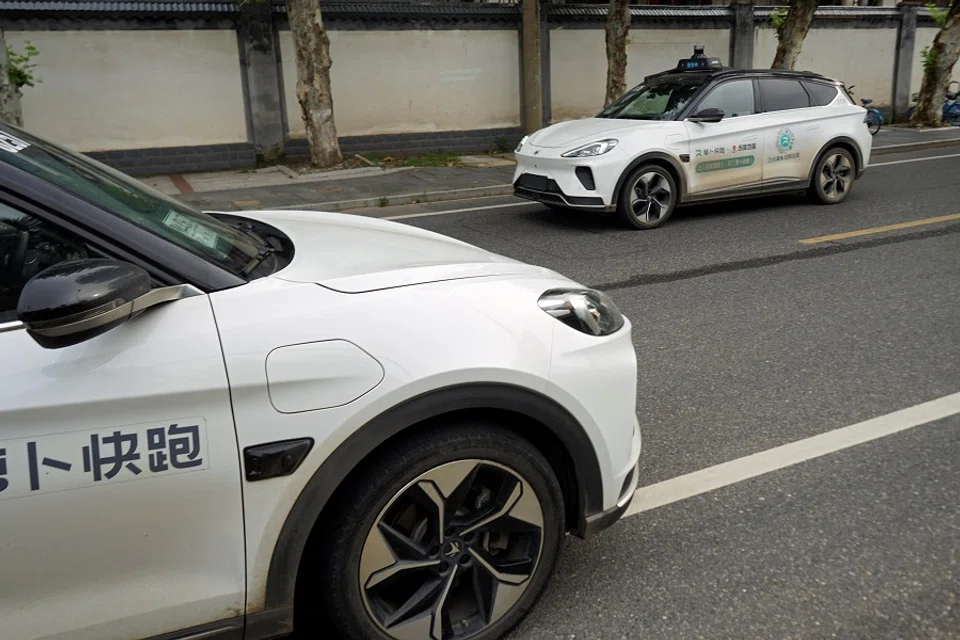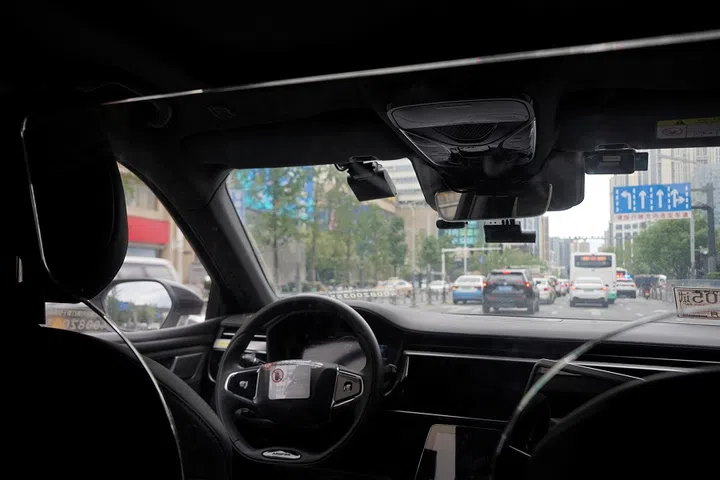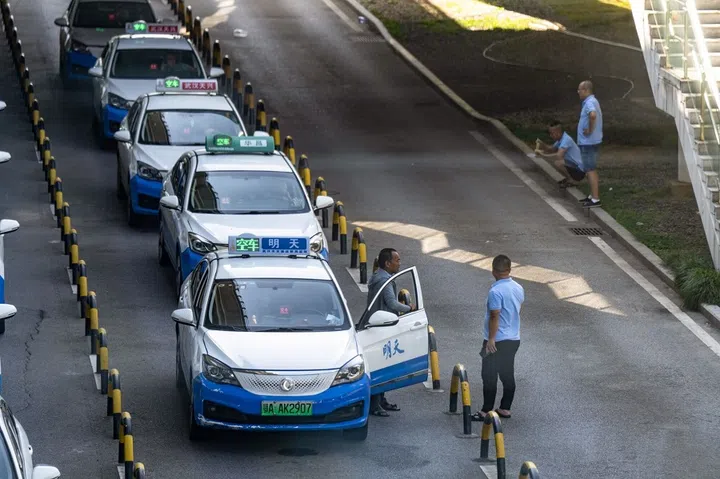Can China lead the way in autonomous driving?
Chinese tech giant Baidu’s Apollo Go has launched driverless test operations in 11 cities. As autonomous vehicles hit the roads, commentator Zhang Tiankan explores their social and safety impacts.

Chinese tech giant Baidu’s self-driving service platform, Apollo Go, has launched passenger-carrying test operations in 11 cities. Since its mass deployment in May 2024, Apollo Go has completed over 6 million self-driving travel service orders.
The integration of self-driving cars into daily life signals the arrival of a future defined by artificial intelligence, digitisation and connectivity. Apollo Go’s current fleet features the world’s first large-scale self-driving model that supports Level 4 autonomy.
At Level 4, the vehicle can handle driving tasks and monitor its environment fully autonomously in specific conditions, without human intervention. The highest level of autonomy, Level 5, represents a vehicle capable of performing all driving tasks independently under any conditions.
Some netizens on social media argue that these “driverless” cars may actually have human operators intervening remotely.
The introduction of Apollo Go into daily life marks a significant milestone in social development and positions China as a potential leader in the age of autonomous driving. However, before this vision becomes a reality, society must address several challenges and resolve key issues related to autonomous driving. The fundamental question remains: as technology advances rapidly, is society equipped with the necessary psychological, behavioural and managerial skills to adapt effectively?
Remote intervention?
Currently, there are questions about whether Apollo Go taxis are genuinely autonomous. Some netizens on social media argue that these “driverless” cars may actually have human operators intervening remotely. They claim that at the Apollo Go control centre, real people are seen operating the vehicles from screens with steering wheels, suggesting a level of human control rather than full autonomy.
In response, Baidu’s autonomous driving test base states that safety operators are indeed present and can perform remote control through 5G cloud driving cabins. “5G cloud driving” refers to the ability of a cloud-based safety operator to remotely assist a driverless vehicle in real time if it encounters an issue that cannot be resolved autonomously.

Whether Apollo Go’s vehicles are truly driverless or remotely operated remains to be determined through further investigation. If it is found that the cars are remotely controlled, this could raise safety concerns, as network failures might lead to accidents. For instance, if a pedestrian suddenly appears in front of the vehicle, even a brief delay in the remote operator’s response could result in a failure to engage the emergency brakes in time, potentially causing serious accidents.
This brings out the central issue in autonomous driving: safety. Is Apollo Go safe?
Safety issues
While Apollo Go’s ride-hailing service has been involved in traffic accidents since its trial operation began, none have been serious. Recently, there was a minor collision with a pedestrian in Wuhan. This indicates that the safety of Apollo Go still requires thorough testing over time and with more operational mileage. Only when it proves to be truly safe will more people have the peace of mind to ride it.
Would-be pioneers of driverless vehicles elsewhere offer a telling comparison: the driverless taxis of Google’s Waymo, and GM’s Cruise, as well as Tesla’s Robotaxis, are all not yet guaranteed to have attained a reassuring level of safety.
Although Cruise received official permits in the latter half of 2023 to run a paid service in San Francisco, US, its driverless taxis were beleaguered by multiple unfortunate incidents — stalling, colliding with a fire engine, blocking an ambulance, dragging a pedestrian — such that its operational eligibility got suspended in just three months.
... they have humorously dubbed the vehicles “shaoluobo” (苕萝卜, lit. stupid carrot), with shao 苕 being the Wuhan dialect for “stupid” or “dumb”.
After safety comes passenger experience. There are very serious doubts as to whether Apollo Go rides are comfortable, convenient and fast (as its Chinese name 快跑 “kuaipao” suggests) and superior to what existing manned taxis or e-hailing services provide.
Passengers in Wuhan who have used Apollo Go report that while the vehicles generally operate smoothly and adhere to traffic rules, they tend to be relatively slow and lack flexibility in complex traffic situations. As a result, they have humorously dubbed the vehicles “shaoluobo” (苕萝卜, lit. stupid carrot), with shao 苕 being the Wuhan dialect for “stupid” or “dumb”. With such characterisations, Apollo Go obviously cannot yet replace most, much less all, manually driven vehicles.
Integration into traffic system
Another concern is whether Apollo Go can integrate with the current traffic management system and adapt to real-world traffic dynamics. For instance, how will liabilities and damages be determined following a traffic accident involving Apollo Go? Additionally, how well does Apollo Go coexist with manned taxis?
Existing traffic regulations appear capable of handling incidents involving Apollo Go. Following a recent minor collision in Wuhan between one of its taxis and a pedestrian who ran a red light, the city’s police reported on 11 July that the accident has been processed, but they cannot disclose the results due to privacy protections.
This means that while China currently lacks national traffic regulations that specifically govern autonomous driving, traffic police departments can still handle liabilities for relevant traffic accidents based on existing laws and regulations, such as the Road Traffic Safety Law and the Provisions on the Handling Procedures for Road Traffic Accidents.
A traffic officer attempted to move the cars, only to discover they were driverless. He had to contact Apollo Go’s customer service and personally drive the cars away to resolve the issue.

If a driverless car violates traffic laws, the owner and manager are responsible for any resulting liabilities. In the event of a traffic accident involving a driverless car that causes injuries or fatalities, the insurance company will cover compensation up to the limit of the mandatory insurance. If this coverage is insufficient, the vehicle’s owner and manager will be responsible for covering any remaining costs.
However, Apollo Go still faces compatibility issues and challenges integrating into complex real-world traffic conditions, highlighting the current limitations of artificial intelligence.
In another recent incident in Wuhan, two Apollo Go driverless vehicles suddenly stopped moving during after-work rush hour, causing traffic congestion. A traffic officer attempted to move the cars, only to discover they were driverless. He had to contact Apollo Go’s customer service and personally drive the cars away to resolve the issue.
What will happen to existing drivers?
Obviously, Apollo Go could take society on a fast track into the smart digital age, as far as transport and physical mobility are concerned. However, this could come at a heavy price.
Taxi and e-hailing drivers in Wuhan and some other cities are already extremely upset about Apollo Go, believing that driverless cars pose a direct threat to their livelihoods.
When driverless taxis become a better transport solution and are safe, comfortable and inexpensive for users, existing manual driving will inevitably be phased out. Most, if not all, manual drivers would face unemployment. This would not only turn the industry on its head, but also impact all of society. What are the drivers and operational personnel to do after losing their jobs?
Now, it seems that the impact from Apollo Go may spark a new Luddite movement. Taxi and e-hailing drivers in Wuhan and some other cities are already extremely upset about Apollo Go, believing that driverless cars pose a direct threat to their livelihoods. They have engaged in malicious and disruptive acts, deliberately obstructing the operation of driverless vehicles and even stopping their own vehicles at traffic intersections to create chaos and attract social attention.
Given these challenges, addressing the perpetrators according to the law is a top priority. However, it is also crucial to address the concerns of taxi and e-hailing drivers by helping them transition to new roles, such as becoming Apollo Go’s backend (cloud) safety operators, to facilitate smoother operations.
Meanwhile, China is adding 19 emerging occupations, including “tester for smart internet-connected vehicles”, to its Catalogue of Occupations. Traditional taxi and e-hailing drivers are more familiar with automotive knowledge and urban traffic, so they have an advantage that can help them transition to these roles more smoothly.
As Apollo Go’s autonomous driving becomes more integrated into daily life and as artificial intelligence increasingly takes over various jobs, a reshuffling of traditional industries is inevitable. Many individuals will need to retrain and adapt to new roles to remain relevant in the workforce. This is painful, but there is no choice, otherwise, one might get left behind by the times.



![[Photos] Fact versus fiction: The portrayal of WWII anti-Japanese martyrs in Taiwan](https://cassette.sphdigital.com.sg/image/thinkchina/3494f8bd481870f7c65b881fd21a3fd733f573f23232376e39c532a2c7593cbc)

